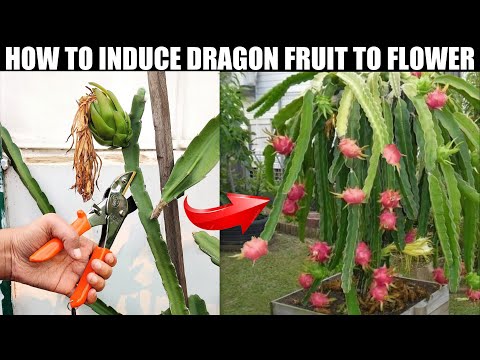Dragon fruit, or pitaya, is a tropical fruit that grows on cacti in warm climates. It has a sweet flavor and can be eaten fresh or used to make smoothies and other dishes. In order to produce dragon fruit flowers, which are necessary for pollination and fruit production, certain conditions must be met. This guide will explain how to induce dragon fruit to flower so that you can enjoy the delicious fruits of your labor.To stimulate dragon fruit to flower, it is important to ensure the plant receives enough sunlight, water, and nutrients. For best results, the plant should receive at least 8 hours of direct sunlight each day and be watered regularly. It is also beneficial to provide a balanced fertilizer to the soil every 2-3 months. Additionally, dragon fruit plants respond well to pruning and deadheading of spent flowers which can help encourage flowering.
Light
Dragon fruit is a tropical plant and needs a lot of light to stimulate flowering. When growing dragon fruit indoors, it is important to provide at least 10 hours of bright light per day. A south-facing window or an artificial grow light will work best. Dragon fruit can also benefit from being placed outdoors in the summer months, as long as temperatures remain above 65 degrees Fahrenheit (18°C).
Temperature
Dragon fruit is a tropical plant and prefers temperatures between 70-90°F (21-32°C). It can tolerate short periods of higher or lower temperatures, but the ideal range should be maintained as much as possible for optimal growth and flowering. The plant should not be exposed to temperatures below 50°F (10°C).
Humidity
Dragon fruit loves high humidity levels, so it’s important to keep the air around the plant constantly humid. The optimal humidity level should be around 70-80%, but anything above 50% will suffice. If you live in an area with low humidity, consider investing in a humidifier or placing bowls of water near the plant.
Soil
Dragon fruit should be grown in well-draining soil that is rich in organic matter such as compost or manure. The soil should also have a slightly acidic pH between 5.5 and 6.5. Adding some sand to improve drainage can also help.
Watering
Dragon fruit needs regular watering during its growing season which typically lasts from spring to late summer or early fall. Water deeply but infrequently, allowing the top few inches of soil to dry out between waterings. The frequency of watering will depend on temperature and humidity levels, so adjust accordingly.
Environmental Conditions For Dragon Fruit Flowering
Dragon fruit, also known as pitaya, is a highly nutritious and delicious tropical fruit. It has become increasingly popular in recent years due to its unique flavor and health benefits. In order for dragon fruit to flower and produce the edible fruits, it must be grown in the proper environment. This includes having the right soil, temperature, light levels, and humidity.
Soil is an important factor for dragon fruit flowering. The soil should be well-draining, light and acidic with a pH of 6 to 7.5. It should also be high in organic matter such as compost or aged manure. Additionally, the soil should be fertilized with nitrogen-rich fertilizer before planting to ensure adequate nutrient availability for flowering and fruiting.
The temperature for dragon fruit flower production should range from 65 to 85 degrees Fahrenheit during the day and 55 to 65 degrees Fahrenheit at night. During flowering season temperatures can drop below 55 degrees Fahrenheit which can cause flower damage or death. Additionally, dragon fruit prefers full sun when in bloom but some afternoon shade can help protect flowers from direct sunlight and heat stress during summer months.
In addition to temperature requirements, light levels are also important for successful dragon fruit flowering. The plant needs at least six hours of direct sunlight each day during flowering season in order to produce flowers and fruits properly. If not provided with ample light levels or if temperatures are too low or too high then this could lead to reduced yields or no flowers at all.
Humidity is another important factor for successful dragon fruit flowering as well as fruiting because it helps regulate transpiration rates so that the plants don’t lose too much water through their leaves during hot weather conditions. The ideal relative humidity level should range between 60-80%. If humidity is too low then this could lead to poor plant growth due to moisture stress while if it is too high then this could lead to fungal diseases such as root rot which could kill the plants entirely before they have a chance to flower or bear fruits.
Improving Chances of Dragon Fruit Flowering
Dragon fruit is a unique and exotic plant that provides delicious and nutritious fruit, but it can be difficult to get it to flower. Knowing the basics of how to care for a dragon fruit cactus can help increase the chances of flowering. With proper soil, light, water and fertilizer, dragon fruit plants will be healthier and more likely to flower.
Providing Proper Soil
Dragon fruit plants need well-draining soil that is slightly acidic (pH 6.0-7.0). They should be grown in a potting mix specifically designed for cacti or succulents or a combination of organic material such as peat moss, compost and perlite. The soil should be kept moist but not soggy as this may cause root rot or fungal issues.
Giving Adequate Light
Dragon fruits require full sun but also appreciate some shade during the hottest part of the day. They should be placed in an area that gets at least six hours of direct sunlight per day. If growing indoors, make sure they are near a south-facing window where they will receive plenty of light.
Maintaining Water Levels
During the growing season, dragon fruits require frequent watering as they do not like to dry out completely between waterings. Once established, water the plants once every 1-2 weeks depending on the weather conditions and size of the plant. During winter months when growth slows down, reduce watering frequency but do not let them dry out completely as this can cause stress on the plant and reduce flowering potential.
Fertilizing Correctly
Dragon fruits need regular fertilizing in order to encourage healthy growth and flowering potential. Use a balanced fertilizer with equal amounts of nitrogen, phosphorus and potassium during spring and summer months when growth is active; reduce fertilizing frequency during fall and winter when growth slows down. It is also important to avoid over-fertilizing as this can burn delicate roots or cause nutrient deficiencies that will affect flowering potential.
Dragon Fruit Flowering and Water Requirements
Dragon fruit is a delicious tropical fruit that is native to Mexico, Central America, and parts of South America. It is a member of the cactus family and is cultivated for its edible fruits. Dragon fruit has a unique look to it; it has bright pink or yellow skin with green or white flesh inside that contains small black seeds. The fruit can be eaten fresh or used in various recipes.
In order for dragon fruit to flower and produce the desired fruits, it must be grown in an environment with specific water requirements. Dragon fruit plants require regular watering during their flowering stage as they are sensitive to drought conditions. It’s best to water the plants deeply, but not too frequently as this will cause root rot and other damage. In general, dragon fruit plants should be watered once every few days during their flowering stage, depending on the weather conditions in the area where they are being grown.
In addition to regular watering, dragon fruit plants also need proper drainage in order to thrive. Poor drainage can lead to root rot and other issues that can prevent successful flowering and fruiting of the plant. To ensure good drainage when growing dragon fruit, choose a soil mixture that has high-quality organic matter such as compost or peat moss mixed in with sandy soil or potting mix. This will help create better aeration and drainage for your dragon fruit plants.
Dragon Fruit plants also need enough nutrients in order to produce healthy flowers and fruits. Adding an organic fertilizer designed specifically for cacti or succulents will help supply your dragon fruit plants with the necessary nutrients for successful growth and flowering.
Overall, providing your dragon fruit plants with proper water requirements throughout their flowering stage will help ensure healthy growth and production of delicious fruits!

Best Light Conditions For Dragon Fruit Flowering
Dragon fruit is a unique, tropical plant that requires specific light conditions for optimal growth and flowering. The best light conditions for dragon fruit flowering are bright, indirect sunlight and warm temperatures. Dragon fruit plants should be kept in an area with temperatures between 70 and 90 degrees Fahrenheit (21-32 degrees Celsius). Direct sunlight can be too harsh for the plant, so it’s best to provide bright but indirect light.
In addition to providing the right light conditions, dragon fruit plants require plenty of water and fertilization. During the spring and summer months, the plant should be watered every two or three days with a liquid fertilizer. During winter months, watering should be reduced to once a week with a balanced fertilizer. Dragon fruit can also benefit from being placed in a humid environment, such as a greenhouse or terrarium.
With the right kind of care and attention, dragon fruit plants will flower in late spring or early summer. The flowers are very fragrant and usually white or pink in color. The blooms typically last for two to three days before they start to wilt and fall off the plant. After flowering, the dragonfruit will begin to form fruits which take several months to ripen.
Overall, providing your dragon fruit plants with bright but indirect sunlight along with regular waterings and fertilization will help ensure that they flower in late spring or early summer. Additionally, keeping the temperature between 70-90 degrees Fahrenheit (21-32 degrees Celsius) and providing them with consistent humidity will help promote optimal growth and flowering of your dragon fruit plants.
Proper Fertilizers For Dragon Fruit Flowering
Dragon fruit is an exotic and vibrant fruit with a unique flavor and texture. It is a popular choice for many gardeners who want to add a little extra color and flavor to their gardens. However, if you want your dragon fruit plants to bloom and produce fruits, you will need to provide them with the proper fertilizers. Fertilizing your dragon fruit plants can help ensure that they get the nutrients they need for healthy growth and flowering. Here are some tips on choosing the best fertilizers for dragon fruit flowering.
The first step in selecting the right fertilizers for dragon fruit flowering is to understand what type of soil your plants are growing in. Different soils have different nutrient requirements, so it’s important to know what kind you’re dealing with before applying any fertilizers. Once you’ve determined the type of soil your plants are growing in, you can then select fertilizers appropriate for that particular soil type.
When choosing fertilizers for dragon fruit flowering, look for ones that contain a balanced mix of macronutrients such as nitrogen, phosphorus, potassium, magnesium, and calcium as well as micronutrients such as iron, boron, zinc, copper, manganese and molybdenum. These nutrients are all essential components of healthy plant growth and flower production, so it’s important to make sure your fertilizer contains them all in adequate amounts.
You should also consider the form of fertilizer you use when feeding your dragon fruit plants. Inorganic or synthetic fertilizers can be fast-acting but may not provide long-term nutrition unless paired with organic matter or slow-release formulations. Organic fertilizers may offer more balanced nutrition but may require more frequent applications than synthetic products.
Finally, consider how often you should apply fertilizer to your dragon fruit plants. Generally speaking, it’s best to feed them once every two weeks during their active growth period from late spring through early fall. During this time period they require more frequent feedings than during their dormant period from late fall through early spring when fewer or no applications should be made.
With these tips in mind you can easily select the right fertilizers for dragon fruit flowering and ensure that your plants get all the nutrients they need for healthy growth and abundant flower production throughout the year!
Pest Control To Induce Dragon Fruit Flowering
Dragon fruit is a popular tropical fruit that has many health benefits. The flowers of the dragon fruit plant are very attractive and fragrant, making them a popular choice for ornamental gardens. However, dragon fruit plants can be difficult to get to flower and bear fruit. One way to encourage flowering is through proper pest control.
Pests such as aphids, mealybugs, thrips and whiteflies can all cause damage to dragon fruit plants and prevent them from flowering. Therefore, it is important to keep an eye out for these pests and take action quickly if they are spotted. Proper pest control methods include using organic pesticides or natural predators such as ladybugs or lacewings.
In addition, proper pruning can help encourage the dragon fruit plant to flower. Pruning should be done in late spring or early summer to remove dead leaves and branches that may be blocking sunlight from reaching the flowers. Removing dead wood can also help ensure that new growth will be strong and more likely to produce healthy flowers.
Finally, fertilizing the soil around the dragon fruit plant can also help promote healthy growth and flowering. Fertilizers should contain nitrogen, phosphorus, potassium, magnesium, calcium and other minerals in order to provide the necessary nutrients for optimal growth and flowering of the plant. Additionally, regular watering is essential for plants that are not receiving enough rainwater naturally.
By following these simple steps, you can ensure that your dragon fruit plants will produce beautiful flowers throughout the season and reward you with delicious fruits later in the year!

Conclusion
Dragon fruit is a beautiful and exotic plant that can be grown in a variety of climates. It is easy to grow and care for, but it can be difficult to induce it to flower. The key to getting your dragon fruit to bloom is providing it with plenty of light, warmth, and moisture. You should also make sure the soil is well-draining and the plant is pruned regularly. If these conditions are met, your dragon fruit should flower reliably each year. With patience and care, you can enjoy the unique beauty of this tropical plant in your own home.
Overall, inducing dragon fruit to flower is not an overly difficult task once you understand its basic needs. All that’s required is patience and consistency with providing the correct environment for the plant. If you follow the steps above, you should have success in getting your dragon fruit to bloom each year.



